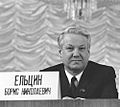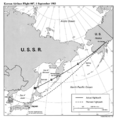Korean Air Lines Flight 007 facts for kids

HL7442, the aircraft that was shot down, at Honolulu in 1981. The aircraft in front of it crashed as Centurion Air Cargo Flight 164 25 years later.
|
|
| Shootdown | |
|---|---|
| Date | 1 September 1983 |
| Summary | Shot down by the Soviet military after navigation error by KAL |
| Site | Sea of Japan, near Moneron Island, west of Sakhalin Island, Soviet Union 46°34′N 141°17′E / 46.567°N 141.283°E |
| Aircraft | |
| Aircraft type | Boeing 747-230B |
| Operator | Korean Air Lines |
| Registration | HL7442 |
| Flight origin | John F. Kennedy International Airport, New York City, New York, U.S. |
| Stopover | Anchorage International Airport, Anchorage, Alaska, U.S. |
| Destination | Gimpo International Airport, Gangseo-gu, Seoul, South Korea |
| Passengers | 246 |
| Crew | 23 |
| Fatalities | 269 |
| Survivors | 0 |
Korean Air Lines Flight 007 (also known as KAL007 or KE007) was a regular flight by Korean Air from New York City to Seoul, South Korea. It had a stopover in Anchorage, Alaska.
On September 1, 1983, the Boeing 747 plane was flying from Anchorage to Seoul. However, it went off its planned path and flew into prohibited airspace over the Soviet Union. At the same time, the U.S. was conducting a reconnaissance (spy) mission nearby.
A Soviet Su-15 interceptor jet shot down the South Korean airliner. The Soviet military thought the plane was a U.S. spy plane. They fired warning shots, but the KAL pilots likely did not see them. The plane crashed into the Sea of Japan near Moneron Island, west of Sakhalin. All 269 people on board, including 23 crew members and 246 passengers, died. Among them was Larry McDonald, a U.S. Representative from Georgia.
The Soviets found the plane's wreckage in the sea on September 15. They also found the flight recorders in October, but they kept this information secret until 1993.
Contents
What Happened During the Flight?
At the time of the attack, the plane was flying at about 35,000 feet (10,668 meters). Recordings from the plane's cockpit voice recorder showed that the crew did not know they were off course. They were unaware they were flying into Soviet airspace.
Soviet Reaction and Global Impact
The Soviet Union first said they knew nothing about the incident. Later, they admitted shooting down the plane. They claimed it was on a spy mission for the U.S. The Soviet leaders said it was a deliberate act by the United States. They believed it was meant to test the Soviet Union's military readiness or even start a war.
The White House in the U.S. accused the Soviet Union of not helping with the search and rescue efforts. The Soviet military also held back important evidence. This included the flight recorders, which were needed for the International Civil Aviation Organization (ICAO) investigation. These recorders were finally released eight years later, after the Soviet Union broke apart.
This event was one of the most tense moments during the Cold War. It made many people, especially in the United States, feel very angry towards the Soviet Union.
Changes After the Incident
Because of this incident, the United States changed how it tracks planes flying from Alaska. The controls for the autopilot system on airliners were also redesigned. This made them easier and safer for pilots to use.
The incident also helped convince the Reagan administration to allow everyone around the world to use the United States' Global Positioning System (GPS). Before this, GPS was mainly for military use.
Today, Korean Air still flies from New York JFK International Airport to Seoul. However, the flight no longer stops in Anchorage. It also flies directly to Incheon International Airport instead of Gimpo International Airport. The flight number 007 has not been used since the incident.
Images for kids
-
A Soviet Sukhoi Su-15 interceptor
-
A typical digital flight data recorder and cockpit voice recorder
See also
 In Spanish: Vuelo 007 de Korean Air para niños
In Spanish: Vuelo 007 de Korean Air para niños














